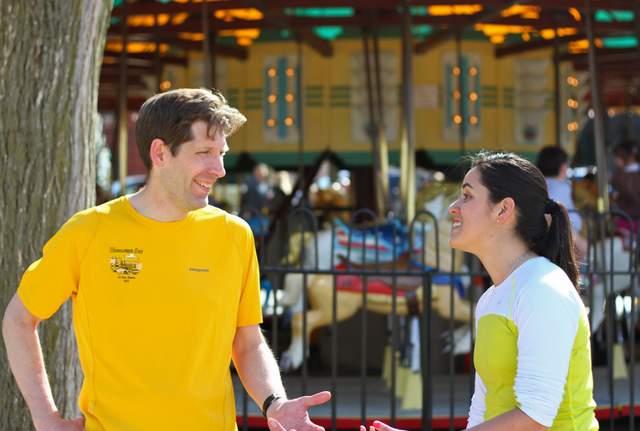
Finding that extra bit of motivation to conquer long runs during marathon training can be a struggle. It’s easy to find yourself running the same routes repeatedly, or seeing the same sights and people nearly every weekend.
Cristina Lopez found herself in this exact situation, but desperation bred inspiration and a run she won’t soon forget.
“I was doing Mt. Vernon Trail for all of my long runs,” Lopez said, who was training for her second marathon, the Rock ‘n’ Roll USA Marathon. “After a while, I knew every bend in that trail. I really needed something to keep me motivated.”
She came up with a goal to help keep her motivated: the “triple tax code” — hitting three different tax codes (Virginia, Maryland and the District of Columbia) in one run.
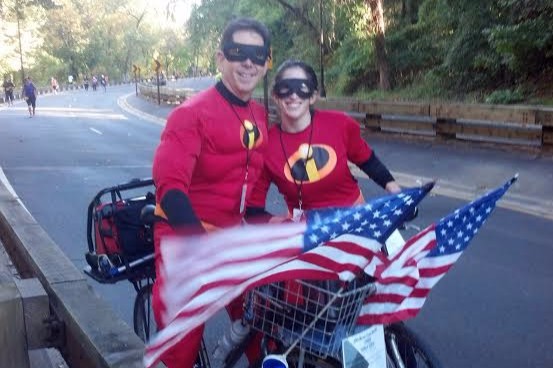
The Enthusiasm Behind the Mask
Max Nacheman saw a red dot in the distance as he approached mile 35 of the JFK 50 Mile. The D.C.-based first-time ultra runner was trudging along a lonely stretch of the course between aid stations and was tired. His knees hurt. Struggling to hit 10-minute miles, he could see his goal time slipping away.
“There was me and one other guy, but we couldn’t see anyone ahead of us or anyone behind us,” Nacheman said. “And we weren’t really talking…we were just suffering next to each other.”
As Nacheman closed in on the red dot on the horizon, he began to hear music. Moments later, the red dot materialized into Disney superhero Mr. Incredible, jumping up and down to music coming from speakers strapped to a bike. No, Nacheman wasn’t hallucinating (though it’s a fair question to ask, during an ultra). There was, in fact, a man dressed up in a costume cheering on runners and dancing to music. At that moment, the motivational song was “Be My Lover” by La Bouche.
“He yelled, ‘take the power out,’ and I hit the gas,” Nacheman said. “I banged out a couple of eight-minute miles. Ultimately, I finished the race and I cleared my goal-time by 30 seconds. I was very happy about that.”
Anyone who has completed a major race in the D.C. area in the last five years (the Marine Corps Marathon, the Rock ‘n’ Roll USA Marathon, JFK 50 Mile, Cherry Blossom) probably has something in common with Nacheman: both have been motivated by the electric jolt that comes from seeing Mr. Incredible among the spectators, dancing to music, dishing out his high fives.
But who is the mystery man who started showing up at races in costume around D.C. five years ago? Who hasn’t missed a JFK 50 Mile since? Who has taken the job of cheerleader and elevated it to superhero status?
His real name is Paul Silberman, DDS. That’s right — Mr. Incredible is a dentist Monday through Friday at his practice, the Silberman Dental Group in Waldorf, Md. While Silberman himself isn’t a runner, his friends are. In fact, that’s how his journey to becoming Mr. Incredible began.
The Road to Mr. Incredible
In 2002, Miles Haven, Silberman’s neighbor in Potomac, Md. at the time, asked if he wanted to ride parts of the JFK 50 Mile course to cheer on members of Miles’ running group called “MilesRun.” Without hesitation, Silberman, who played doubles tennis with his neighbor, agreed. He was given speakers to strap on the front and back of his bike in an effort to create the “stereo effect.”
When race day arrived, Silberman parked at the finish line, then strapped the speakers onto his bike with duct tape.
“He came out, played the music and we ran,” Haven said. “I remember he just had a great time…and Paul continued doing it.”
Silberman eventually upgraded his sound system to two large speakers, which require large and expensive batteries and puts the weight of the bike at more than 100 pounds. Six years after his first JFK 50 Mile, he came up with the idea of putting on the costume.
“I just put it on as a goof at the JFK 50 and the response of the people was so different than somebody on a bicycle with music,” Silberman recalled. “It’s like there was a superhero on a bicycle with music. People’s jaws drop when a non-human is cheering them on. They’re just so willing to smile and be receptive to cheering and high-fives.”
His friends noticed the transformation, too.
“When he’s in costume, people just treat him differently,” Haven said. “Like he’s a friend. Like he’s one of the family. It’s interesting to see that. It’s like he’s not a human, he’s somebody else. They’ll just run around and treat him a little different than if he was just a normal person. That costume does a lot, they’re more gracious that he’s there.”
After several years of supporting runners in D.C.-area races, many runners now expect him at major races. But they aren’t the only people who have noticed what Silberman brings to a race. By 2013, Mr. Incredible was part of the official “entertainment” of the Marine Corps Marathon and was given permission to ride the course with his bike while jamming out to Journey’s “Don’t Stop Believin'” or Survivor’s “Eye of the Tiger.”
In 2014, Marine Corps invited Silberman back again and earned a spot in the media guide as “Mr. Incredible, The Marathon Bike Guy.”
“We’re glad to have him as part of the team and we’re glad he’s an official entertainer for a variety of reasons,” said MCM Operations Manager Charlie Harr, who approved Silberman’s plan and credentials for the race three years in a row. “Having coached with a charity-based training program, I see what the people in the back are going through and know how hard it might be mentally for them to continue and see the value he brings to those runners.”
Harr, who also benefited from Mr. Incredible’s energy jolt at one JFK 50 Mile, said prior to race day, Marine Corps officials brief law enforcement partners on the entire entertainment plan, including Mr. Incredible’s case.
“We provide him vehicle credentials for his bike so that law enforcement on the course know that he’s supposed to be there and he has been properly vetted,” Harr said. “We essentially just make sure that they’re aware of what our intentions are and that Paul is part of plan.”
No Easy Task
Silberman preps for races in the same way a runner would. He hydrates the night before, anticipating that he won’t have many opportunities to stay hydrated during the race. He spends hours perfecting his race-day playlist. He arrives early. He makes one last trip to the bathroom before putting on his costume.
And just because he gets on his bike when runners’ shoes hit the pavement, doesn’t mean he’s not burning any calories.
During this year’s JFK 50 Mile, he rode nearly 60 miles. That’s while lugging more than 100 pounds. The temperature at the finish line that day was a miserable 16 degrees — not quite ideal biking temperatures.
During Marine Corps, Silberman starts his day at 6:30. He rides the course until he reaches mile eight and stays there to give out high-fives and cheer on runners until 10 a.m., when most of the runners have gone past this point. Then he rides down the course to the 14th Street Bridge at mile 20 where he sets up to give runners one last boost to the finish. Getting from one place to another isn’t always smooth.
“Each year I learn a lot,” Silberman said. “Next year I won’t go around the Pentagon with the runners. I got stopped every 50 yards by security with semi-automatic rifles.”
It’s a good thing they did. While cheering during the 2014 Marine Corps Marathon near mile 25, Silberman came across a wheelchair-bound disabled veteran who couldn’t move his arms anymore.
Silberman told the veteran that he could help push him in an effort to get some momentum to the crest of the hill and onto the downhill prior to reaching the last hill in the race. Silberman added, “But if I do, I don’t know if that disqualifies you for a medal.”
Silberman contacted the race coordinator the day after the race to confirm the vet received his medal, which he did.
“It doesn’t matter, I’m stuck and I can’t move,” the veteran told Silberman.
Silberman ran with the veteran from the Pentagon parking lot and helped him take off to the steep hill at the end of the race. He recounts this experience as “the first time he has run in the last 20 years.”
A Runner at Heart
Mr. Incredible most recently picked up a sidekick: his daughter, Lauren, who lives in D.C. Lauren ran cross country and track in high school and college and has started to join her father in costume at races as “Violet.” She said that her father understands running culture even better than some runners.
“He gets running, running culture and running life better than any non-runner I’ve ever met,” Lauren said. “He has a feeling of what’s in a runner’s head at a certain point of the race. That sheer exhaustion when you can’t think of anything, then this character pops up. Or how sometimes you need just a little bit of encouragement, you need to be told to go just a little faster.”
Silberman typically never crosses the finish line himself in races, except for in the JFK 50 Mile. But even then, he doesn’t receive a medal or any of the other race memorabilia participants get to take home with them after a job well done. Yet he keeps showing up to the next race year after year.
“He’s not just a guy putting on a costume,” his daughter said. “He’s a guy who found a way to insert himself in running culture and to make that a hobby without necessarily running the full 26.2 miles.”
After a long day of dancing, biking and running back and forth cheering on runners, the man in the costume will unload all of his equipment, mount his bike on the back of his car and head back home. He’ll hang up his costume and mask until the next race. When Monday morning rolls around, the avid cyclist will walk into his dental practice and start seeing patients.
“I have come to appreciate what a runner does to be able to complete a marathon, much less an ultra,” Silberman said. “The physical and mental training is remarkable. I have a huge amount of respect for the runners. There are times during the race when I clearly am receiving as well as giving … and there is something powerful about helping people when you know they have nothing to give in return.”
This article originally appeared in the Winter 2015/2016 issue of RunWashington
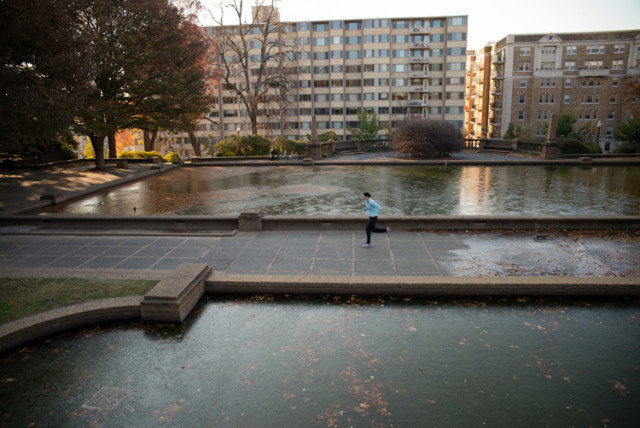
I rolled over on an air mattress in my empty apartment and glanced at the clock that read 4 a.m. I couldn’t fall back asleep — my entire body ached, chills ran through my bloodstream and I had severe nausea. I was just hours away from a 15-hour car ride to Wisconsin and there I was — grappling with the flu. But the car ride was the least of my concern. In just a few hours, I was supposed to lace up my shoes to go for my last run before I moved to Madison.
The sky got lighter but my body still ached. The nausea had only gotten worse and the thought of going outside exacerbated my chills. Nevertheless, it was my last opportunity to “run the District,” the phrase I’ve used throughout the years as a Washington running blogger, and I planned on taking full advantage. So I layered up and stepped out the door.
While the first few steps were painful, the thought of heading back to my warm apartment didn’t cross my mind for a second. I ran down 16th street, past the White House. I ran up and down the steps of the Lincoln Memorial and then circled the Washington Monument where I looked out at the Jefferson Memorial and U.S. Capitol. Albeit a few structural changes, these historical buildings haven’t changed, they’re still the same landmarks with the same purpose — but the way I looked at them had changed.
I stopped seeing these structures as important buildings that changed history and eventually thought of these landmarks as mile markers for runs. The Lincoln Memorial: my halfway point of a five-mile route after work. The Washington Monument: a bathroom stop and a beacon for water fountains. The Jefferson Memorial: an indication that I’m in for a long run that day.
These buildings will always be the iconic symbols of Washington, but to me they’ll always be routes along a run that hold athletic import.
I’m not the first and definitely won’t be the last person to part with this town. The revolving door is part of living in Washington. Many runners like myself have escaped the busy streets of D.C. and found themselves running in quieter parts of the country.
After living in Washington for six years, former D.C. runner Doug Hay moved to North Carolina with his wife. His runs now mostly consist of exploring the mountains and trails of North Carolina, but he says he’ll “forever miss the familiar singletrack (trail)” that was one of his only constants during the six years that he lived in D.C.
“There is something magical about having Rock Creek Park as a natural oasis in the middle of a bustling city,” Hay said. “The rush I got from the instant transition of horns and crowded sidewalks to dirt trails and swaying Beech trees is unmatched here in Western North Carolina.”
While Hay still runs and trains for races, after leaving D.C., Jake Marren’s life took a different turn. He went from constantly complaining about 90-degrees and smog to bundling up and exploring quiet snowmobile tracks in single-digit temperatures.
After living in D.C. for three years, Marren and his wife moved to Vermont, where they started a family and bought a house in Montpelier. The 2013 Boston Marathon was his last competitive race.
“Georgetown Running Club was the center of my social scene and the central part of my life while I was in D.C.,” he said. “It’s a very different lifestyle (in Vermont). I still run quite a bit… but it’s definitely not the same running scene that D.C. had. I really do miss having a club and things like that — on the other hand, my lifestyle is so different. I still run six days a week, at least. But I probably put in
less miles because I’m not putting in a 20-miler with the club on Sundays, which would be the kind of thing I’d do when I was in D.C. But now when it’s Sunday, I want to drink coffee and hang out, and if I go for a run, great.”
Marren and I aren’t the only ones who are welcoming the escape from 90-degree temperatures. According to the D.C. Office of Planning, 44.1 percent of millennials (individuals between the ages of 20-34 years old) from other states moved out of the city in 2012.
But that same city data also showed that 51.5 percent of millennials from other states are moving into the city. There’s a reason so many of us move to D.C. in the first place. From vibrant neighborhoods to numerous career opportunities, D.C. has lots to offer. The same is true in terms of running. D.C. gave me the confidence and resources to complete 26.2 miles. If I was ever lacking motivation, I could tap into any of the numerous running groups. If I ever needed a race to gauge my speed, I could choose from dozens of races in the area every month, no matter what time of year it was. The top-notch running stores alone make this town a runner’s heaven. I’m well aware that every other city I live in will never come close to the running community in D.C.
Ellen Gilmer is back in D.C. after attending graduate school in Portland, Ore., another community where running is pervasive. As great as Portland was, her career steered her back here.
“Portland is a running mecca, but when I returned to D.C., I remembered how much I love running in the glow of the Capitol building and the monuments. I’ve rediscovered other local gems like Rock Creek Park, the National Arboretum and the Potomac Heritage Trail, and I’m always inspired by my surroundings and fellow runners,” she said.
After making a loop around the Washington Monument, I made my way back north toward my apartment. I stopped in Logan and Dupont Circles. I purposely ran in the middle of side streets lined with brownstones, the roads covered in fallen Ginko Tree leaves. I ran every corner of Meridian Hill Park, and took a sip of water out of my favorite water fountain in Mitchell Park.
One of the last stops on my run involved sneaking on private property: Just a few blocks north of U Street lies a street filled with several townhomes. If I’m able to get on the edge of one of the properties at the right time in the morning, I can usually see what I think is one of the best views of the city. Fortunately, none of the residents were awake yet, and I arrived just in time to watch the sunrise stretch across the monuments, various buildings downtown, the row houses of Adams Morgan and parts of Virginia for one last time.
Just as I saw the sun stretch across the entire city, I thought about how my life — running life, that is — in D.C. stretched across the city: When my running shoes and I made the most out of the closed streets to traffic as the rest of the city followed the president on the parade route or stayed at home and watched on TV. When I conquered the last hill of the Marine Corps Marathon in 2011 and then again in 2013; or that time I live-tweeted a 20-mile run.
Nearly every run, every race and every speed workout the last four years took place in D.C. And that’s why it was so important to ignore my fever and nausea that morning — I had to run through my city one last time for a proper goodbye.
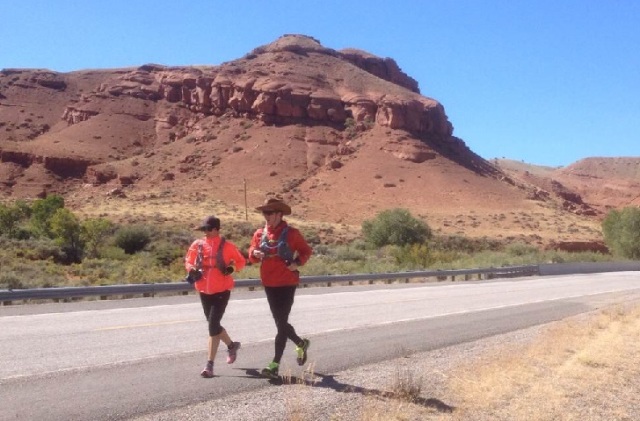
The greatest risk to Ashley Donovan and Adam Meyer, as they ran to Washington, D.C. from Portland, Ore., wasn’t the wear and tear on their bodies. It was the wildlife — close calls with a rattlesnake and roughly a dozen dogs on the road.
Since July, the duo not only trekked thousands of miles across the country on foot (3,165 miles to be exact), but also met with more than 100 community leaders in nearly a dozen states.
[button-red url=” http://www.run2connect.com/” target=”_self” position=”left”] More about their trip[/button-red]“We’re both feeling great,” Meyer said just a few days after completing the 113-day run. “I think we finished the run stronger than we started to be honest.”
Both said that it took about a month or so to get their bodies into shape and used to the heavy mileage but after finishing, Donovan said they could have kept going.
“We were happy we had a day off but we both could have gone out and kept running,” Donovan said. “And we would have been happy doing it.”
Meyer added that the running part of their trip wasn’t “that difficult.”
“It’s sort of funny how your body adjusts to compensate for needing to do something crazy like this,” Meyer said. “Your body just gets used to a certain action. I mean, it’s incredible how smart your body is. But now we’re both in really good shape (for running). We both agree that the largest challenge was logistics for us. Once we got out running…it wasn’t that difficult to just put in the work. But the challenging parts were organizing all of this because it was just two of us most of the time.”
While it was just the two of them organizing the trip, they also had some help from family and friends to drive their support vehicle for parts of the trip, an RV nicknamed Rex. The RV was used as a place to sleep, eat, shower, prepare website updates and most importantly a storage area for more than a dozen running shoes (most of which were destroyed by the end of the trip). And by having friends and family drive the RV through parts of the trip, many times Donovan and Meyer were able to run side-by-side.
“We’d have the best conversations when we were running,” Meyer said. “Get the blood flowing and your mind you can really think a lot.”
A typical day on the road started at 6:30 a.m. After some breakfast, they’d head out for their run and put in as many hours of running as they could until they passed through a town where they usually had a meeting set up with community leaders. After a meeting with either a mayor, police chief, fire chief, or even a governor on one occasion, they’d put in as many more miles as they could until sunset and then eat dinner, update their website and get some sleep. The next day, they’d wake up and do it all again.
The trip was filled with 113 running days and eight “rest days,” which weren’t actually rest days for the two. These eight days mostly consisted of meetings that took up most of the day.
They both needed to consume 5,000 to 7,000 calories per day, which meant never having to worry about what they ate.
“We had the mentality from the start — after talking to people who actually did this much quicker than we did — if it’s real food and sounds good, try it,” Donovan said. “We’d get some greens in the system very early on with a smoothie and that was a pretty great start to the morning. Usually some eggs, maybe a bagel with peanut butter. Mornings for me were usually the healthiest part of the day.”
After crossing Oregon, Donovan and Meyer ran through Idaho and Wyoming. From there, they ran across wind-swept Nebraska, Iowa, Illinois, Indiana and Ohio. Most of this leg of the trip took place on rural roads until they hit Pittsburgh, where they hopped on the Great Allegheny Passage that took them all the way to Cumberland, Maryland. From there, they took the C&O Canal into D.C. While they hadn’t planned on doing the entire trail system from Pennsylvania to D.C., which tacked 130 miles on the trip, they still managed to finish close to their end-date goal.
“Nobody understands quite how that worked but yeah we were very diligent about trying to stay on schedule,” Meyer said. “At one point, we were about a week behind and then we made up that time over two months.”
The lack of overuse injuries still amaze the pair.
“We we’re both amazed that we came out as well as we did without having done a lot of regular stretching and rolling out and all those runner things to do,” Donovan said. “We did it when we absolutely needed to but to be completely honest we were so busy trying to go to meetings.”
Their bodies were not only kind to them, but Mother Nature lent them a hand as well.
“We probably had less than six or eight days of rain on the whole trip,” Meyer said. “Very little rain. We had a lot of wind. There were a number of very cold days. But until we hit Chicago, which is two-thirds of the way across the country, I don’t think we had any cold days except going over the continental divide. We were in shorts and a long sleeve shirt. Until then, it was pretty amazing.
Their main goal throughout the trip was to interact with communities along the way. But sometimes this meant adding a few more miles to the trip.
“When we saw an opportunity, we usually took it,” Donovan said. “If that meant adding more miles we were happy to do that.”
Donovan and Meyer cited several success stories they heard in towns along the way, including a few towns where local businesses, leaders and local government collaborated to prepare kids for jobs that they could use in those communities. Donovan said because a lot of kids wanted to go back home after college, the goal was to “create an actual working force to then work in the community.” These stories and more was one of the main reasons Donovan and Meyer set out for the trip.
“The other part of the goal is to go through all these stories we learned and pick out really some of the simpler ones that can easily be replicated,” Donovan said. “Part of it is just to communicate, share ideas and not reinvent the wheel. You can adapt these ideas and try it out so we just got to figure out the most effective way to do that.”
The challenge after the trip is to figure out how they’ll share these stories with the lack of resources.
“This was a very important thing for us just personally to learn more about the country and share some of these ideas and just the physical challenge of it,” Meyer said. “But to be completely honest, we are just flat broke. We put in every dime we have and more.”
As for taking advantage of the endurance they’ve built up, Meyer and Donovan don’t have any races on the calendar yet or feel any urgency to compete. At the same time, both don’t have the need to take too much time off of running.
“Running has taken on a meaning of joy and pleasure as opposed to competition,” Meyer, a former University of Oregon mid-distance runner, concluded.
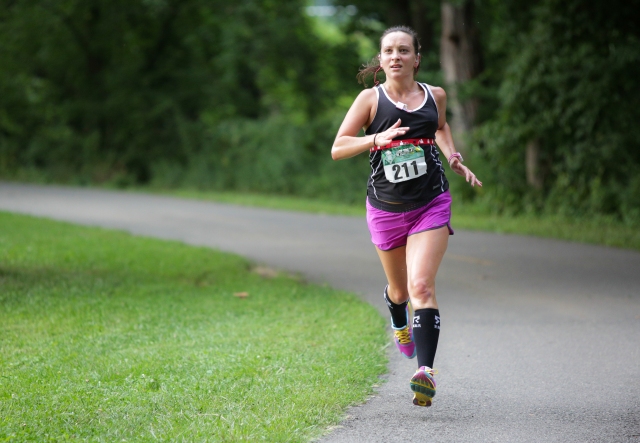
Dr. Breanna Gawrys, a captain in the United States Air Force, will conquer the 2014 marathon on much more training and sleep than she did during the 2013 Marine Corps Marathon.
“I was working a lot more — like 70-80 hours per week — so I didn’t have a whole lot of time to get the training in so this year is going to be a lot better,” she said.
Gawrys was referring to the long hours she spent as during her internship. But even with a time-demanding career last year, she still ran the race in 3:36:05.
“You’ve got to find the time to have the time,” she said.
Now, a resident in family medicine at Fort Belvoir Community Hospital, she’s getting a little more sleep and said she’s had a few more hours to train.
“The energy of the spectators and to have the marines there is very inspiring,” Gawrys said, adding that running next to wounded warriors also motivates her. “I keep coming back because it’s one of my favorite races.”
Gawrys was only 19 years old when she completed her first marathon, Marine Corps, and earned a spot in the Boston Marathon. She was second in her age group and came through the finish line in 3:30:04. Gawrys’ first marathon experience was still fresh in her head.
“Some guy spit on my leg during the bridge. He wasn’t intending to but it sort of ended up there.”
But getting spit on didn’t deter Gawrys in the least. Eight marathons later, she’ll be aiming for a 3:25 to 3:30 finishing time in this year’s race.
“I try to maintain a good mental attitude throughout the race so I’ve just trying to get myself in that mindset,” Gawyrs said of her training. “I tried to incorporate Haines Point because that’s usually the point where I find myself unhappy during the race so I’ve been trying to think positives thoughts during it.”
Gawrys channeled her enthusiasm early on in college when she created the Duke Roadrunners.
“We would just sign up for races together and go run them,” Gawrys said.
Even though she caught the marathon bug early on, she plans on sticking with the sport long term.
“I want to stay active with the sport and not get injured and not over do it so when I’m older I can keep going back to Boston — that’s really the goal,” she said.
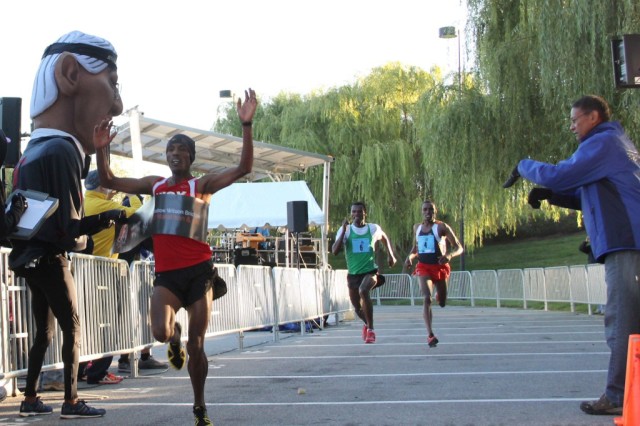
There was no calendar hopping this year for the Woodrow Wilson Bridge Half Marathon, the first of the region’s races to bear the brunt of the federal government shutdown last year. The race ended up postponed until early November, but temperatures were cooler in the fifth running in 2014, with runners bundled in spandex, hats and gloves in early October.
While many weren’t expecting the low temperatures, most runners were thrilled to race in the crisp and cool air so early in the fall.
“I don’t think it’s a hyperbole, I think the conditions were pretty perfect,” Kevin Ford said.
[button-red url=”http://results.chronotrack.com/event/results/event/event-10571″ target=”_self” position=”left”] Results [/button-red]The race serves as the Visually Impaired National Half Marathon Championship and turned out dozens of visually impaired athletes with the help of guides along their side. Erich Manser traveled all the way from the Boston area to compete in the race.
“I ran this course two years ago and I like the improvements they made,” Manser said. “As a visually impaired athlete, it made it a little user friendly for me.”
Nearly a year ago, Manser had knee surgery for a torn meniscus and had to take the rest of 2013 off. But he was able to start training again in January, made it through Boston, then completed a few triathlons. By late summer, Manser said he started to feel like he got his “groove back.”
“I’m not doing it without the guides,” Manser said. “It’s people that are so selfless and give up their own race to be out here. Such amazing athletes. Everyone’s got their own reason for being out here and it’s circular. You know, I love to feel like I inspire and I’m inspired by so many. It’s a wonderful thing.”
Alex Heiche and Laura Greason, also from the Boston area, helped guide Manser throughout the race. Both were pleasantly surprised with his pace.
“Erich gave us quite a challenge today to keep up with him,” Greason said.
The race featured generous cash prizes and attracted numerous elites to the field. Bobby Mack, member of the Reebok team, held the lead during the first three miles of the race.
“But for a half marathon that doesn’t really mean much,” Mack said.
Mack took the lead again near mile seven, but a pack of eight followed close behind and eventually overcame him. Once they reached mile 12, Girma Gebre, Gosa Tefera and Derege Demie broke away. The race came down to seconds, with Gebre breaking the tape at 1:03:50. Tefera finished second with the same tame as Gebre and Demie finished third one second later.
Mack said he plans to return to the area in November when he will compete in the .US National Road Racing Championships in Alexandria.
The female division also brought out fast elite runners, including Lilian Mariita (first) and Etaferahu Temesgen (second). The two held an impressive five-minute lead over the rest of the pack. Mariita crossed the line at 1:12:33 and Temesgen at 1:12:44. Joyce Kandie was the next female to come through with a time of 1:17:31.
The 13.1-mile course started in Mt. Vernon then headed north on the George Washington Parkway toward Alexandria, where runners were greeted with lots of crowd support. Then they crossed the Woodrow Wilson Bridge (as the name of the race suggests), which stretches out more than a mile and includes several rolling hills.
Roberto Rodriguez, who has run with DC Road Runners for 35 years, said this year’s race marked his fifth time crossing the bridge.
“I’ve run all five of them,” Rodriguez said. “You can’t argue with a day like today.”
Rodriguez also competed in last year’s race in November.
Some runners chose to defer their registrations a year after the race announced the new date, including Mark Njore of Dumfries, Va.
“I didn’t think I was ready,” Njore said. “It was a good excuse to defer. But I made sure to be ready this year.”
But by waiting a year, his friend Francis Agula was able to joined him in this year’s race.
The race seemed to attract many first-time half marathon finishers, including Alyssa Rucker who crossed the finish line with a Lack Braddock Cross Country shirt. Rucker said she picked a weekend that her cross country team didn’t have any meets to run a half marathon.
“I’ve been wanting to do [a half marathon] for a while,” Rucker said, and added that her coach had no idea about the race. “I’m sure he’ll find out at some point. Hopefully he’s okay with it. I did well so that’s good.”
Rucker said she’ll eventually complete a marathon but probably not for a couple of years.
“Hopefully sometime when I’m an adult,” she said.
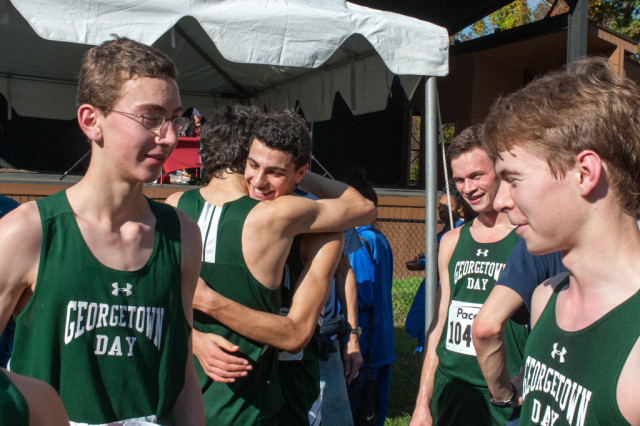
When Anthony Belber was brought on as an assistant track coach at the Georgetown Day School 17 years ago, the GDS Hoppers could hardly fill a school bus.
“The first year I coached, we only had four girls and 10 to 12 boys in cross country,” he recalled.
But fast forward 17 years later, and the team can now fill multiple school buses as well as trophy boxes. In addition to winning numerous state and conference championships, the team has also won the D.C./Maryland Private School Championships.
Belber attributes most of their success over the years to the team’s participation numbers — which has risen to 80 athletes in cross-country and more than 90 in track in a school that has only 450 in its total student body.
“The biggest change over the years has been our numbers.” Belber said. “It’s always been about getting kids to participate — that’s the key. Even though we’re very much enjoying the success at the top, it’s still about everybody wanting to be part of the program. Not only do I enjoy coaching everybody, but I think when everybody is working hard at every level, you get better results at the conference championships.”
Belber noted that he personally experienced programs that were welcoming to athletes of all levels and abilities and saw the value of coaching the complete child and not treating the athletes as “one-dimensional runners.”
“I liked that it had a struggling athletic program,” Belber says. “I admit I dreamed that someday I could turn it into a running powerhouse like St. Albans or Haverford. The goal then and now, though, is to expose kids to the joys of running and help them recognize the lessons they learn in the sport carry over to every other facet of their lives.”
Though the team has seen a tremendous amount of success throughout the years, Belber said funding for the program hasn’t increased much and the team is still without a track.
“We do most of our training on the streets of D.C.,” Belber says. “We find some trails to run in Rock Creek Park and things like that. But we have to rent the American University track a few times a week so we’re limited to the days that their team isn’t using it.”
But that hasn’t stopped the team from top performances in track, either. The boys’ track team has taken home four conference championship titles. Belber said his assistant track coaches played a large part in their success. Sprinting coach William Miezan competed in the 1996 Olympic Games in Atlanta as a sprinter on the 4x100m relay team for Cote D’Ivoire.
“Without a doubt, our team would not be where it is today were it not for the coaching our sprinters, jumpers, and hurdlers have been receiving from him for the past 13 years,” Belber said.
GDS also added another assistant track coach, Brian Bobo, who has been with the program for a dozen years and is the reason they’ve sent two triple jumpers to Division I programs despite having no jumping facility of their own.
Belber also attributes the team’s success to backing off in mileage and workouts.
“If anything in the last four years, we’ve backed off the number of workouts we do instead of trying to squeeze two hard workouts in a week in addition to a meet,” Belber said. “Year-round, we do one hard workout a week and one meet a week. I think that recovery time is a huge part of our success. Even our top boys are probably doing mid-30 (miles per week) throughout the season. And our girls do a little less.”
Although Belber attributes all the teams’ success to his assistant coaches, cutting mileage and rising participation numbers, his former athletes say that’s just part of it. Ben Stern, a GDS alumnus who was a junior when Belber first started coaching, said most of the success should be credited toward Belber.
“As soon as Belber came on as coach, I saw dramatic improvements,” Stern said.
When Stern went off to Princeton and later Oregon, his little brother Alex followed him through GDS. He was worried that Belber might base his expectations based on his brother’s career,said the complete opposite happened.
“His tireless dedication to the program and individualized attention to every athlete is why the team has seen such dramatic improvements,” Alex said. “He never treated me as ‘Ben’s little brother.’ He treated me as Alex.”
Alex added that Belber’s coaching style and techniques have stayed with him since high school — particularly keeping a cool and calm approach to everything in life.
In addition to the numerous championship titles Belber can be credited for, he was also a finalist in the 2014 Brooks Running Inspiring Coach of the Year. It’s no wonder 10 different alumni have come back as assistants, which Belber said was also key the team’s success over the last decade.
The alumni have kept an active Facebook page, and according to Belber, “are more tightly bonded than any other alumni faction within the school community.”
Belber saw firsthand how bonded the community has become after a former runner passed away.
“The way these runners and alumni came together… it meant a lot to me as a coach,” Belber said. “I love the fact that a lot of our running alumni stay involved. When we go to big meets, the local alumni will cheer and so even though we feel like the rest of the school may not understand or appreciate what the runners are doing, we still feel a big sense of community.”
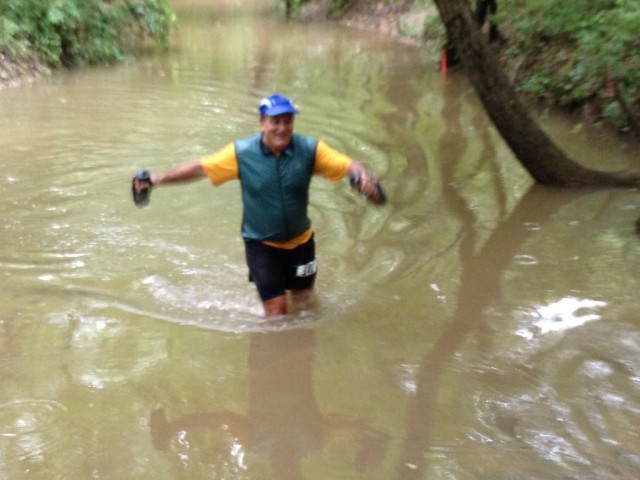
Working out the logistics for a 50-state marathon goal is almost just as difficult as completing 50 marathons. The list begins to add up quickly: race registration fees, cost for travel and accommodations, maneuvering time off of work, and the list goes on.
Race series have sprung up to give traveling runners a chance to knock out several states in one trip, often with races five days in a row. One such company, Altis Endurance Sports, based in Annapolis, brought that approach to the Potomac River, with five back-to-back trail marathons, in Meyersdale, Pa.; Keyser, W.V.; Frostburg, Md.; Annandale, Va. and Washington, D.C.
Thursday’s race, in Annandale’s Wakefield Park, brought out several of these so called “50-staters,” to run Fairfax’s Cross County Trail.
“Right now I’m at 30 states,” said Heather Gallacher who participated in the entire series so she could knock off five marathons in just a week. “And by Friday I’ll complete my 109th marathon.”
The Pennsylvania native said she had no idea D.C. was such a “trail running town”
“If you had never done any of these trails before it’s a great way to discover them,” she said. “I was blown away. That’s been one of the coolest things about this particular series—discovering the unknown. It was one of my most memorable runs and one I’ll never forget.”
Race directors Mike Samuelson and Frank Dembia head the endurance company and said last week’s series was hopefully one of several more events to come.
“I’ve been a long-time Rails-to-Trails Conservancy member,” Samuelson said. He earned fame in the ultrarunning community after completing a 3,302-mile run across the country in 80 consecutive days. “I’ve always loved rail trails and towpaths. They’re just so fantastic to run.”
According to Samuelson, Dembia had the idea to direct races more than 20 years ago. The two met in the Navy in California and completed several marathons and ultra marathons together. Once Samuelson finished his trans-America run, Dembia confronted him again with the idea to create the endurance company.
Their event on Thursday attracted a wide range of participants from all kinds of backgrounds, including 11-year-old Nikolas Toocheck of Chester County, Pa. Toocheck, who had the day off of school and came to Annadale with his father Dan, completed his seventh marathon on seven continents earlier this month and raised more than $40,000 for charity, providing coats to children through “Operation Warm.”
Toocheck snuck the marathon in between his wrestling and baseball practice.
“If you train really hard and put your heart to something you can accomplish it,” the 11-year old said.
The endurance series also included a half marathon. Former Washington, D.C.-area resident Julie Crespi won the women’s half for Thursday’s event. Crespi came down for the series from Rhode Island.
“I was going to come visit a friend in the area and saw a Thursday race,” Crespi said. “And then I saw there was an entire series. So I figured I could drive down and hit them all along the way.”
The cross country course was changed just moments prior to the race due to flooding of the trail system in Wakefield Park. The area received several inches of rain the night before and the sky continued to pour during the morning hours of the race as well. But even with a course change, runners still dealt with slick terrain and even waded through a deep gully that went past most runners’ knees.
“What I love is having something to stick in my mind for one of these,” said Marvin Solberg, who had just completed his seventh marathon of the year and has a long-term goal to eventually complete all 50 states. “The start was classic. We all went astray. We all went past the gully and went the wrong way.”
Runners completed more than 10 loops along the course to reach 26.2 miles, which meant they had to wade through the same gully several times.
But Solberg said he didn’t hear a single complaint from any of the runners.
“It’s part of the excitement of hanging out with people like this,” he said. “It’s very positive energy and everyone that was here just did it. Running marathons is all about overcoming adversity. So when little things like that arise, it’s just part of the fun.”
For 2015, race directors Samuelson and Dembia are planning a nine-state marathon series in Maine, Vermont, New Hampshire, New York, Massachusetts, Rhode Island, Connecticut and Pennsylvania.
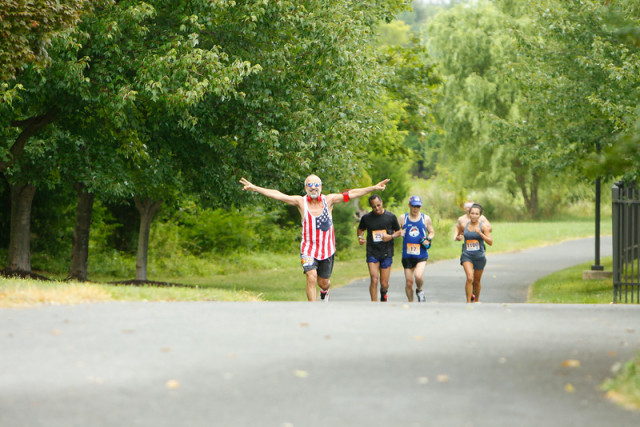
When most race registration websites encourage runners to sign up their particular event, Riley’s Rumble Half Marathon cautions participants.
“Don’t be seduced by the lush bucolic countryside of rural Montgomery County,” it said. “This race will challenge the best runners. If you want the 3 H’s (hills, heat, and humidity), this is the race for you.”
[button-red url=”http://www.mcrrc.org/rileys-rumble-1″ target=”_self” position=”left”] Half Marathon Results [/button-red]Despite all of this discouragement, more than 400 participants showed up to the starting line at 7 a.m. to conquer what they knew and expected to be a tough course. In fact, those words of warning were part of the draw.
“If another guy suggests to do something challenging or possibly stupid, I don’t back away,” Sasha Rourk of Washington, D.C. said. “It’s definitely tougher on country roads with a lot more hills. But there’s fewer tourists than the Mall.”
Rourk said his colleague, Arie Heijkoop, recommended the race to him in preparation for the Marine Corps Marathon he plans to run in this fall.
“It’s probably the toughest thing I’m going to do this year,” Heijkoop said. “I think everything they say about these races are true — Park’s Half Marathon is the ‘nice half.’ And this is the race ‘your mother warned you about.’”
The race used to take place along the C&O Canal at Riley’s Lock (the race’s namesake). But after logistical difficulties, race director Joel Carrier said, the course moved to its current location in Boyds, near the South Germantown Recreational Park. Carrier said he prefers the new course but added “I wait until the fall to run it.”
“It’s the nicest day we’ve had in years,” he said while talking about the temperatures, which were in the low 70’s with a few sprinkles of rain. “Usually it’s hot and humid.”
Riley’s Rumble is one of several events among MCRRC’s low-key race series. While there were no awards, t-shirts or finisher medals, one of the temptations to sign up for the race was the low cost: free for club members or a $21.40 registration fee for everyone else—a steal for a half marathon near Washington, D.C.
The low cost was what lured Scott Smith of Bellaire, Md. into signing up. He’s currently in the midst of attempting 13 half marathons in 13 months. He said he’s running three of these halves in August, solely because they were the most affordable.
“This was a bargain and I try to do as many bargains as possible,” Smith said.
Smith is also training for numerous marathons in between his half marathon challenge.
“It’s gonna be a tough week,” Smith, who has another half marathon coming up next week, said. “But Maryland in general is a hilly place and it will toughen me up for the marathons.”
Though the race website recommended first timers steer away from Riley’s Rumble, the event marked Nicole Dawson’s first half marathon. She’ll not only remember her first half marathon because of the course, but also because of the fact that she was the first woman to come through the finish.
At only 19 years old and a junior at the University of Maryland, Baltimore County, won the women’s division by nearly two minutes, with a time of 1:32:28. She ran the first half of the race with her UMBC teammate, Sarah Zielinski, then broke away.
Megan Haberle of the Dojo of Pain was also among one of the top women to come through the finish. She felt like she was in a state of shock at staying upright for 13 miles after being dogged by injuries all spring. She added one of her favorite things about the low-key race series is how supportive the other runners in the race were.
“I’m a small town girl at heart and this recaptures that same feeling I remember when I watched my dad run small 10k races,” Haberle said.
She added that she also enjoyed the rural scenery.
“It’s a beautiful course,” she said. “You’re not breathing in car exhaust, you’re just looking out in the landscape. It’s a nice distraction.”
Jim Dahlem of Silver Spring said he was quite surprised to see how rural Montgomery County actually was.
“This is by far the most rural half marathon I’ve ever done,” he said. “We passed through farms and cows all on country roads.”
That wasn’t the only aspect of the race that surprised him.
“When you’re going downhill in the beginning you don’t realize how steep it’s going to be coming back because you’re not tired yet.”
Though Dahlem had a few surprises, he still managed to finish third in his age group.
The top finisher in the race, who’s now a back-to-back first place finisher winning this year’s and last, MCRRC racing team member Nicolas Crouzier passed through the finish line at 1:17:03 — a 4:37 lead over second place finisher Miles Aitken. Crouzier said he aimed to run each mile a little quicker than his marathon pace.
“I started out with 5:45 per mile then eased up a little after a few miles,” Courzier said.
The MCRRC competitive team recruited Courzier after he won this race last year . He added that the low-key races series put on by the club is a favorite of his.
“I just love these small local races,” he said. “You don’t have to worry about medals or anything like that, it’s just pure and simple racing—and that’s what I like.”
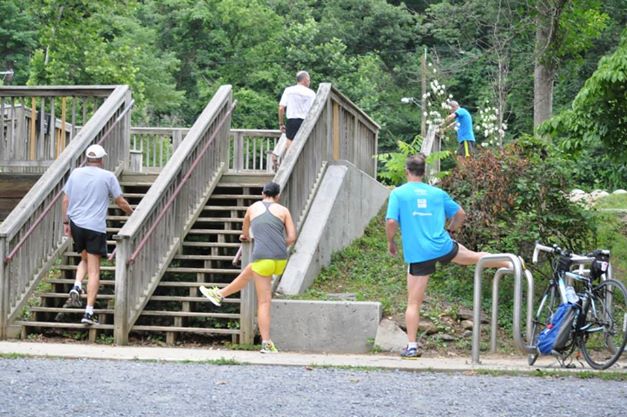
The second race of the D.C. Road Runners Club Bunion Derby race series was underway Saturday evening at the Hugh Jascourt Memorial 4-Miler. More than 80 runners turned out on Saturday evening on the C&O Towpath near Fletcher’s Boat House to celebrate its club’s founding president’s birthday, Hugh Jascourt. And with a welcomed break from the humidity, many were pleased to compete on the low-impact, out-and-back course along the canal.
[button-red url=”http://www.zippyraceresults.com/search.php?ID=4076″ target=”_self” position=”left”] Four Mile Results [/button-red]Kate Katz of Arlington, Va. took the lead right off the bat in the women’s division and held it till the finish with a time of 26:32, making it her second win in a row in the Bunion Derby series.
“We’ve been training in such hot weather lately so this felt great,” Katz said. “I liked the terrain, too, it’s easier on the body.”
Since the last race, Run After the Women 5K, involved the men catching the women, Katz was excited she had more competition with her.
“It was nice to have some men to chase after,” Katz said.
The overall top finishers, Karsten Brown, Oliver De Greet and Joe Kane, held the lead for most of the race until the last mile, where Brown pulled away from De Greet and Kane, finishing with a time of 22:39. Brown, who just completed a 100-mile race a few weeks ago, said he’s been competing in the Bunion Derby series since the 90’s.
Betty Blank of Falls Church, Va., who is ranked first in her age group on the East Coast, has been competing in the Bunion Derby series for several years.
“I love D.C. Road Runners Club races,” Blank said. “It’s a good group of people with great competition. And it’s fun because everybody knows everybody and we all help each other out.”
In addition to several DCRRC regulars, the race also turned out some non-local D.C. runners.
Tim Loughran, a professor at Notre Dame, wanted to fit in a race while he was visiting D.C. Despite most of the runners gleaming with joy because of the break from humidity and high temperatures, the weather didn’t impress the Indiana resident.
“Running along the canal was nice but it was a little hotter than I’m used to compared Indiana temperatures,” Loughran said. “I like running in the cold.”
But Allan Ingraham of Arlington, Va. who competed in this race in 2013, said the temperatures last year were 10 degrees higher. Though temperatures never stop Ingraham from competing.
“These races just have a good group of folks, gets your heart rate up and lets you feel a little bit of pain.”
Ann and Steve Brown of Vienna, Va., who regularly participate in DCRRC races, said they too appreciate the low-races put on by the club.
“They get you out there and give you something to work towards,” Ann said.
Finishing just a few seconds after Ann, Laurie Horstmann of Centreville, Va. said in addition to the race series, she’s a big fan of the four-mile distance as well.
“It’s not as short as a 5k but not too long either,” Horstmann said. “And it’s nice not to be stressed out about the distance unlike longer races.”
Horstmann is on her 39th year running and said there has been many “ups and downs” throughout the years.
The DCRRC Bunion Derby series will include six more races this summer, three in July and three in August. To be eligible for an age group reward, club participants must run three races. The participant’s top five races will count in the total scoring for the series. Runners must also volunteer at a qualifying event or activity with the club.

